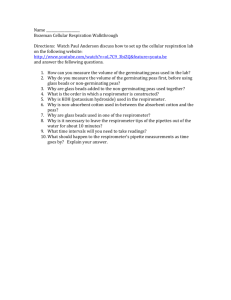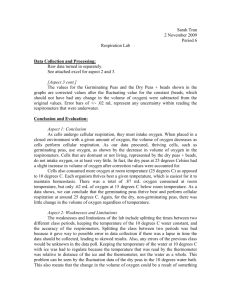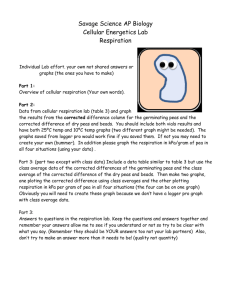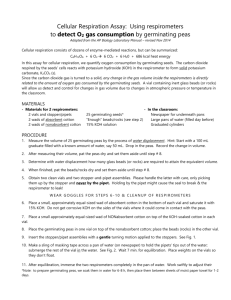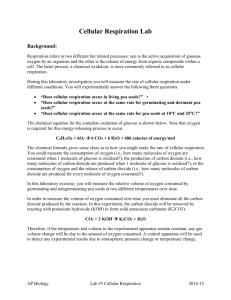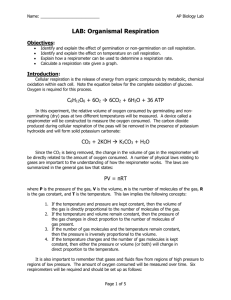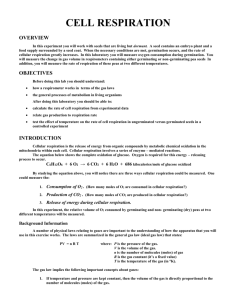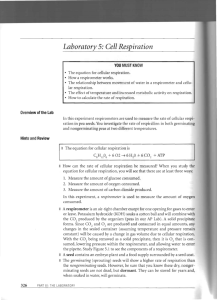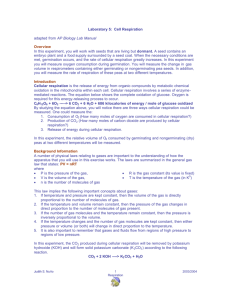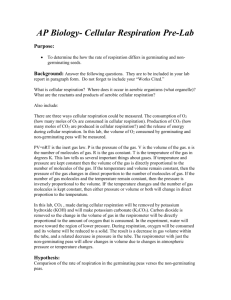AP Lab 5 Cell Respiration
advertisement
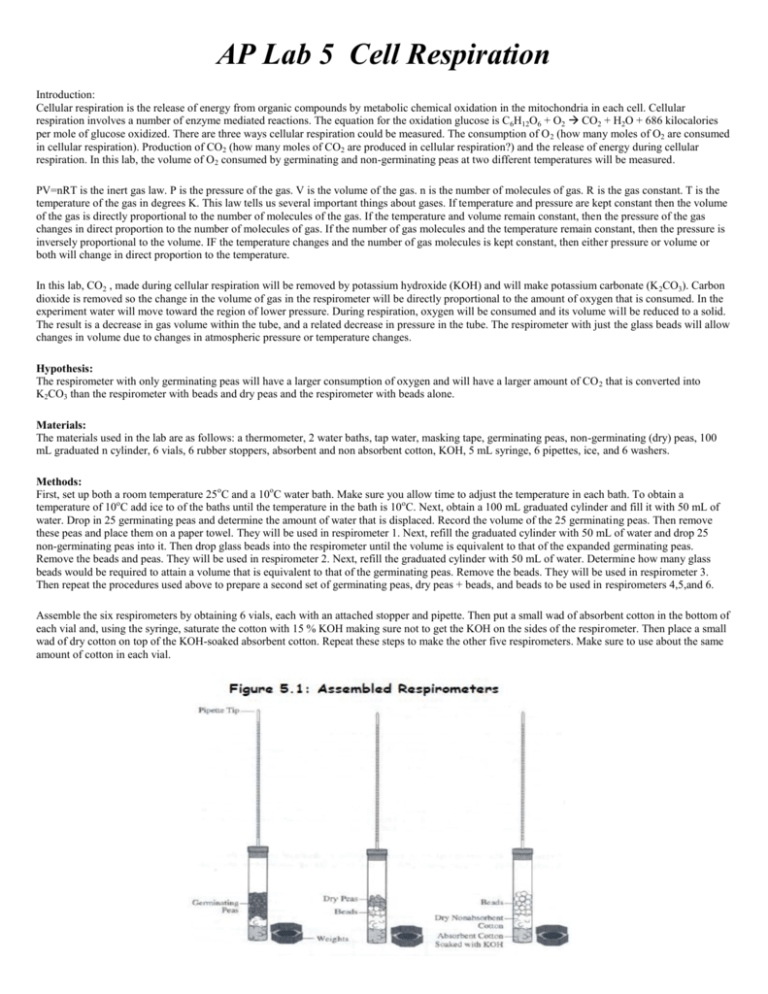
AP Lab 5 Cell Respiration Introduction: Cellular respiration is the release of energy from organic compounds by metabolic chemical oxidation in the mitochondria in each cell. Cellular respiration involves a number of enzyme mediated reactions. The equation for the oxidation glucose is C6H12O6 + O2 CO2 + H2O + 686 kilocalories per mole of glucose oxidized. There are three ways cellular respiration could be measured. The consumption of O 2 (how many moles of O2 are consumed in cellular respiration). Production of CO2 (how many moles of CO2 are produced in cellular respiration?) and the release of energy during cellular respiration. In this lab, the volume of O2 consumed by germinating and non-germinating peas at two different temperatures will be measured. PV=nRT is the inert gas law. P is the pressure of the gas. V is the volume of the gas. n is the number of molecules of gas. R is the gas constant. T is the temperature of the gas in degrees K. This law tells us several important things about gases. If temperature and pressure are kept constant then the volume of the gas is directly proportional to the number of molecules of the gas. If the temperature and volume remain constant, then the pressure of the gas changes in direct proportion to the number of molecules of gas. If the number of gas molecules and the temperature remain constant, then the pressure is inversely proportional to the volume. IF the temperature changes and the number of gas molecules is kept constant, then either pressure or volume or both will change in direct proportion to the temperature. In this lab, CO2 , made during cellular respiration will be removed by potassium hydroxide (KOH) and will make potassium carbonate (K 2CO3). Carbon dioxide is removed so the change in the volume of gas in the respirometer will be directly proportional to the amount of oxygen that is consumed. In the experiment water will move toward the region of lower pressure. During respiration, oxygen will be consumed and its volume will be reduced to a solid. The result is a decrease in gas volume within the tube, and a related decrease in pressure in the tube. The respirometer with just the glass beads will allow changes in volume due to changes in atmospheric pressure or temperature changes. Hypothesis: The respirometer with only germinating peas will have a larger consumption of oxygen and will have a larger amount of CO 2 that is converted into K2CO3 than the respirometer with beads and dry peas and the respirometer with beads alone. Materials: The materials used in the lab are as follows: a thermometer, 2 water baths, tap water, masking tape, germinating peas, non-germinating (dry) peas, 100 mL graduated n cylinder, 6 vials, 6 rubber stoppers, absorbent and non absorbent cotton, KOH, 5 mL syringe, 6 pipettes, ice, and 6 washers. Methods: First, set up both a room temperature 25oC and a 10oC water bath. Make sure you allow time to adjust the temperature in each bath. To obtain a temperature of 10oC add ice to of the baths until the temperature in the bath is 10oC. Next, obtain a 100 mL graduated cylinder and fill it with 50 mL of water. Drop in 25 germinating peas and determine the amount of water that is displaced. Record the volume of the 25 germinating peas. Then remove these peas and place them on a paper towel. They will be used in respirometer 1. Next, refill the graduated cylinder with 50 mL of water and drop 25 non-germinating peas into it. Then drop glass beads into the respirometer until the volume is equivalent to that of the expanded germinating peas. Remove the beads and peas. They will be used in respirometer 2. Next, refill the graduated cylinder with 50 mL of water. Determine how many glass beads would be required to attain a volume that is equivalent to that of the germinating peas. Remove the beads. They will be used in respirometer 3. Then repeat the procedures used above to prepare a second set of germinating peas, dry peas + beads, and beads to be used in respirometers 4,5,and 6. Assemble the six respirometers by obtaining 6 vials, each with an attached stopper and pipette. Then put a small wad of absorbent cotton in the bottom of each vial and, using the syringe, saturate the cotton with 15 % KOH making sure not to get the KOH on the sides of the respirometer. Then place a small wad of dry cotton on top of the KOH-soaked absorbent cotton. Repeat these steps to make the other five respirometers. Make sure to use about the same amount of cotton in each vial. Next, place the first set of germinating peas, dry peas + beads and beads in vials 1,2, and 3. Place the second set of germinating peas, dry peas + beads, and beads in vials 4,5, and 6. Insert the stoppers in each vial with the proper pipette. Place a washer on each of the pipettes to be used as a weight. Make a sling using the masking tape and attach it to each side of the water baths to hold the pipettes out of the water during the equilibration period of 10 minutes. Vials 1,2, and 3, should be in the bath containing water of 25o C. Vials 4, 5, and 6 should be in the bath containing water that is 10oC. After the equilibration period completely immerse all six respirometers in the water completely. Water will enter the pipette for a short distance and stop. If it does not stop, there is a leak. Make sure the pipettes are facing so you can read them. The vials should not be shifted during the experiment and your hands should not be placed in the water during the experiment. Allow the respirometers to equilibrate for three more minutes and then record the initial water in each pipette time 0. Check the temperature in both baths and record in table 5.1. Every five minutes for 20 minutes, take readings of the water’s position in each pipette, and record the data in table 5.1 Table 5.1: Measurement of Oxygen Consumption by Soaked and Dry Pea Seeds at 25 °C (Room Temperature) and 10 °C Using Volumetric Methods Temp. (°C) Time (min.) Beads Alone Reading at time X Diff. 1 Germinating Peas Reading at time X Diff. 1 Corrected diff. 2 Dry Peas and Beads Reading at time X Diff. 1 Corrected diff. 2 Initial-0 0.95 0.93 0.94 0-5 0.93 0.86 0.91 0-10 0.92 0.79 0.89 0-15 0.92 0.73 0.89 0-20 0.92 0.66 0.87 Initial-0 0.97 0.94 0.93 0-5 0.96 0.90 0.92 0-10 0.94 0.87 0.89 0-15 0.92 0.85 0.88 0-20 0.92 0.82 0.87 25 10 1 Difference = (initial reading at time 0) - (reading at time X) 2 Corrected difference = (initial pea seed reading at time 0 - pea seed reading at time X) - (initial bead reading at time 0 - bead reading at time X) ANALYSIS OF RESULTS: 1. Graph the results from the corrected difference column for the germinating and dry peas at both room temperature and at 10 oC. Use a different color for each type of seed at each temperature (4 colors), be sure to include a title and a legend for your graph and label your axes (your independent variable should be on the x-axis). Once your points (for times 0, 5, 10, 15, and 20) are plotted, draw an approximate “line of best fit“ for each set of data (you’ll have 4 lines – you may find it easier/better to use your calculator to find the lines of best fit). Graph 5.1: (Descriptive) Title: ___________________________________________ Questions: 1. In this activity, you are investigating both the effect of germination versus non-germination and warm temperature versus cold temperature on respiration rate. Identify the hypothesis being tested in this activity. 2. This activity uses a number of controls. What was the purpose of the: a. Beads b. KOH c. Respirometer d. Germinating Peas e. Non-Germinating Peas 3. Explain the relationship between the amount of oxygen consumed and time. 4. From the slope of the four lines on the graph, determine the rate of oxygen consumption of germinating and dry peas during the experiments at room temperature and at 10o C. Condition Show Calculations Rate in mL O / minute Germinating peas at 10oC Germinating peas at room temperature Dry peas at 10oC Dry peas at room temperature . 5. Why is it necessary to correct the readings from the peas with the readings from the beads? 6. Explain the effect of germination versus non-germination on pea seed respiration. 7. Graph the predicted results through 45o C. Explain your prediction. 8. Why did the vial have to be completely sealed around the stopper. 9. If you used the same experimental design to compare the rates of respiration of a 25g. reptile and a 25 g. mammal at 10 oC what results would you expect? Explain your reasoning. 10. If respiration in a small mammal were studied at both room temperature 21 o C and 10oC what results would you predict? Explain your reasoning. 11. Explain why water moved into the respirometers’ pipettes. 12. Design an experiment to examine the rates of cellular respiration in peas that have been germinating for 0, 24, 48, and 72 hours. What results would you expect? Why?
